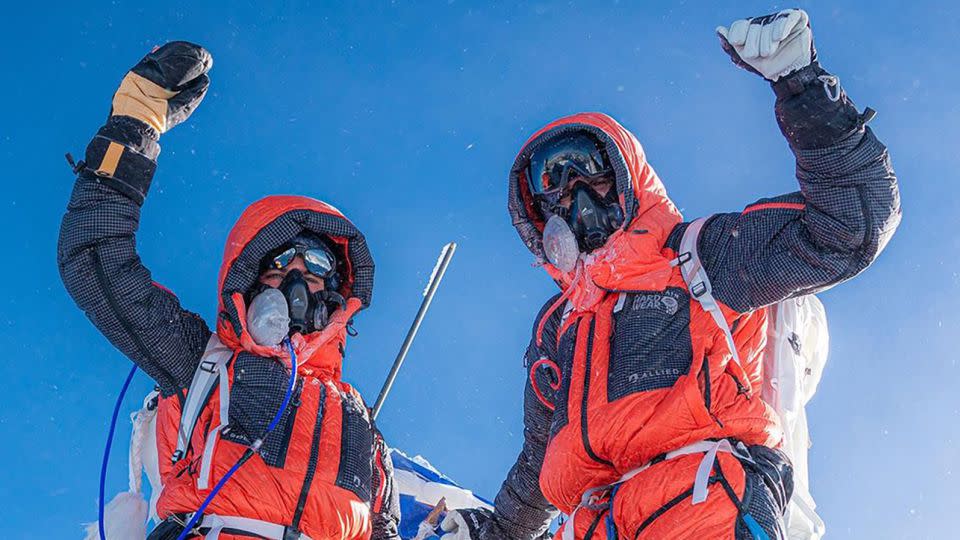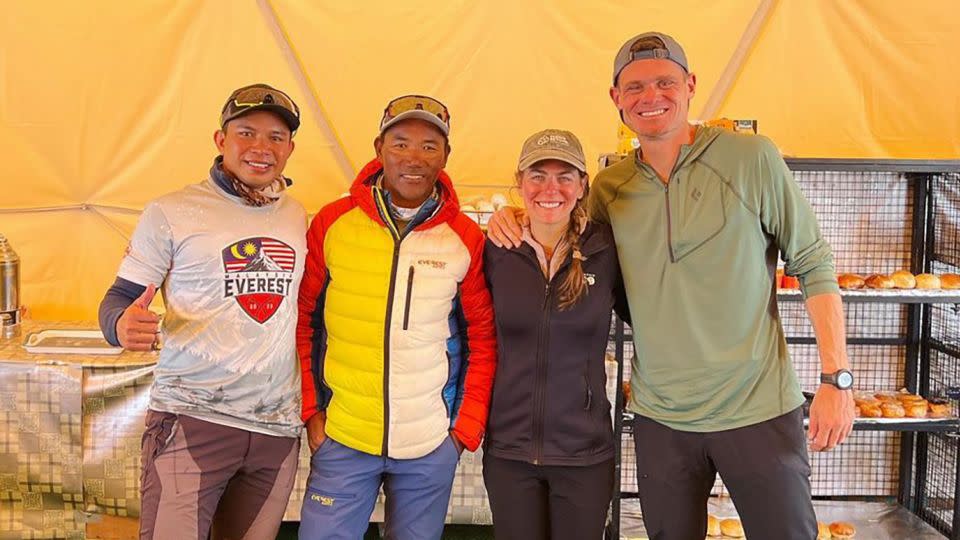Deaf climbers make history on Mount Everest
How do you sign if you’re holding an ice ax? Do guides refuse to work with you if you can’t hear? What happens if you can’t see each other signing at night?
Those are just some of the issues that American adventurers Scott Lehmann and Shayna Unger have addressed on their YouTube channel, which documents their experiences as a Deaf couple working their way to the peaks of the world’s tallest mountains.
On May 22, Unger and Lehmann became only the third and fourth Deaf people to summit Mount Everest. Unger is the first Deaf woman ever.
By coincidence, on the way up Unger and Lehmann met only the second Deaf person to reach the top – Malaysian national Muhammad Hawari Hashim – who scaled the peak on May 18 and was seen grinning proudly while holding the Malaysian flag in an image shared on social media.
That three Deaf people climbed the world’s highest mountain within days of each other – just a few years after a ban on disabled climbers was overturned by the Nepali supreme court – sent waves of pride through the global Deaf community.
The World Federation of the Deaf estimates that there are 70 million Deaf people in the world, using more than 300 different signed languages.
Unger and Lehmann are among that number. CNN interviewed them via Zoom in American Sign Language (ASL).
Deaf climbers on the rise
Until this year, only one Deaf person had ever summited Everest – Japanese climber Satoshi Tamura, an alpine skier who succeeded on his third attempt, in 2016.
The following year, Nepal announced that it would no longer issue climbing permits to people with disabilities, which included Deafness, with some claiming that it would create more work for Sherpas on the mountain to accommodate them.
The decision enraged climbers with disabilities, including Hari Budha Magar, a Nepal-born Gurkha soldier who became a double amputee when he stepped on an IED while serving in Afghanistan.
He was one of a coalition of disabled Nepalis who fought the ban in Nepal’s Supreme Court, and in 2018 it was repealed.
Magar successfully summited Everest on May 19 this year, becoming the first double above-the-knee amputee to complete the ascent.

Climbing up and over
The Everest environment can make communication difficult for anyone, Deaf or not. Winds and swirling snow can make it hard to see and hear each other; darkness adds an additional layer of visual challenge.
Unger and Lehmann have been a couple since high school, but they only started climbing together in 2015, when they summited Kilimanjaro.
Lehmann had much more experience after taking a cross-country trip with friends after graduating from Gallaudet, the world’s only liberal arts university for the Deaf and hard of hearing.
He fell in love with climbing, but was frustrated by the lack of resources available in his native ASL.
He signed up for a course, but the instructor informed him he’d have to hire and pay for an interpreter himself, then get an interpreter to accompany him on every expedition. Instead, he turned to YouTube, but most videos were not subtitled, or the automated captions were not good enough to follow.
Mostly, he said he learned through trial and error, by watching other climbers and copying them. He then taught Unger how to climb.
Normally, the couple use the voice-to-text translation app Big to communicate with guides and other climbers, but the phone signal at high altitudes is dicey at best. Even something as simple as typing is challenging at 25,000 feet – they would have to remove their gloves in order to use the touchscreen, which can be risky in such cold temperatures.
Unger and Lehmann decided to assume no technology would work for them on Everest and set out to learn to communicate as much as possible without it.
Before the climb, they worked with their Sherpas in advance to learn some basic ASL and agree on visual cues and signals that they could all use. By the third week of climbing together, the couple and their sherpas were able to interact easily, without using an app or writing things down on paper.
The extra pre-climb work proved critical.
Near the summit, Lehmann’s mask filled with ice and he began to panic. However, he was able to communicate with his Sherpa, who quickly fixed the mask and got the group back on track.
“There’s a lot of different barriers we had to go through to get to Everest, so when we reached the top we felt like, we overcame the odds,” says Unger. “We were really proud of ourselves.”
At Everest Base Camp, Unger and Lehmann had befriended Hashim, the Malaysian climber. He saw the couple signing and came over to introduce himself.

Though they didn’t have a signed language in common, the trio became friends – communicating via a mix of ASL, International Sign Language, and gestures.
Hashim beat the couple to the peak on May 18, but he hasn’t been seen since. He disappeared the next day while descending from the summit to Camp Four.
The Malaysian and Nepali governments assisted in a search mission, which was ultimately abandoned on June 6.
This year was a dangerous one on the mountain. Nepal was widely criticized for issuing its highest number of climbing permits ever, amid concerns about potential overcrowding. Twelve climbers are confirmed to have died in the 2023 season, with another five – including Hawari – missing.
It is likely that Unger and Lehmann were the last two Deaf people Hashim saw before he died.
“Of course we know that mountain climbing comes with risks,” says Unger. “But it happened to our friend, and our Deaf community, and it’s not easy for us.”
Signs of the future
The couple now aims to be the first Deaf climbers to complete the Seven Summits – the highest mountains on each continent. Only 460 known individuals have achieved the feat.
Their successful Everest ascent puts them more than halfway to their goal – in addition to Kilimanjaro, they’ve also summitted Aconagua and Denali, the highest peaks in South and North America respectively.
“With the right attitude and the right adjustments, (the outdoors) is available for Deaf and hard of hearing people,” says Lehmann. “It’s available for people with disabilities.”
He then talks about what he hopes that Deaf and hard of hearing kids will think when they see that two Deaf adults have conquered the world’s tallest mountain.
In ASL, a way to show emphasis on a word is by repeating a sign several times, growing larger or more urgent.
When talking about his aim to inspire Deaf and hard of hearing youth, Lehmann repeatedly uses the sign for “dream,” which looks like an inflated balloon, but he inflates the balloon until it’s bigger and bigger and bigger, nearly covering his whole body.
It’s hard to translate this concept into English.
But, as Lehmann and Unger’s mountain climbing experiences show, ambition makes sense in every language.
For more CNN news and newsletters create an account at CNN.com

